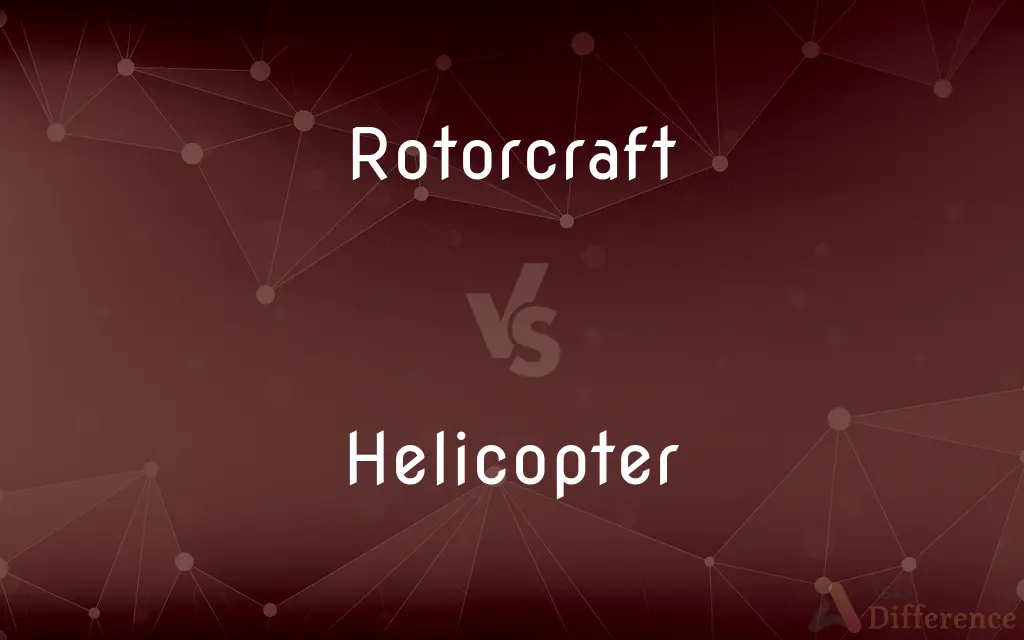Rotorcraft vs. Helicopter — What's the Difference?
Edited by Tayyaba Rehman — By Urooj Arif — Updated on March 22, 2024
Rotorcraft are aircraft using rotor blades to lift and propel, whereas helicopters specifically use rotors for vertical lift and horizontal motion.

Difference Between Rotorcraft and Helicopter
Table of Contents
ADVERTISEMENT
Key Differences
Rotorcraft encompass a broad category of aircraft that rely on rotor blades to generate lift, allowing them to take off, land vertically, and, in some cases, hover. This category includes various types of aircraft, including helicopters, which are the most widely recognized form of rotorcraft. Helicopters are distinguished by their ability to take off and land vertically, hover, and fly forward, backward, and laterally, thanks to the unique design of their rotor blades, which can be pitched collectively or individually to control flight.
One of the key differences between rotorcraft and helicopters is their scope. Rotorcraft serve as an umbrella term for all aircraft that use rotors to generate lift, which includes helicopters, but also extends to autogyros and other innovative designs that might not fit the conventional helicopter mold. While helicopters are designed for a wide range of civilian and military applications, offering considerable versatility and maneuverability, rotorcraft as a category opens the door to various other aviation technologies and concepts that utilize rotor systems.
The design and operation of these aircraft types further highlight their differences. Helicopters typically feature one or more large horizontal rotors and may also have a tail rotor to counteract the torque effect of the main rotor. Other rotorcraft, like autogyros, operate on a different principle, where the rotor is not powered but instead uses autorotation to generate lift as the aircraft moves forward, propelled by a conventional engine.
Another notable distinction lies in their historical development and applications. While helicopters were developed during the early 20th century and have found extensive use in transportation, search and rescue, military, and other roles due to their vertical takeoff and landing (VTOL) capability, other rotorcraft have been explored for specialized uses, benefiting from their unique aerodynamic properties.
When considering the future of aviation, both rotorcraft and helicopters represent areas of innovation, with advancements in drone technology and VTOL aircraft for urban air mobility. However, the specific engineering and operational capabilities of helicopters position them as a crucial component of current and future aviation landscapes, while the broader category of rotorcraft suggests continued exploration and diversity in aerial mobility solutions.
ADVERTISEMENT
Comparison Chart
Definition
Broad category of aircraft using rotors for lift.
Aircraft using rotors for vertical lift and flight.
Types Included
Helicopters, autogyros, etc.
A specific type of rotorcraft.
Flight Capabilities
Can include VTOL, but varies by type.
Typically includes VTOL, hover, and 360 movement.
Main Rotor System
Varies, can be powered or unpowered (autorotation).
Powered, with precise control for maneuverability.
Applications
Diverse, depending on specific design.
Wide-ranging, from military to civilian use.
Compare with Definitions
Rotorcraft
Capable of vertical takeoff and landing (VTOL).
Most rotorcraft designs emphasize VTOL capabilities.
Helicopter
Utilizes a tail rotor to counteract torque.
The tail rotor on a helicopter helps maintain stability during flight.
Rotorcraft
Diverse applications depending on design.
Rotorcraft are used in search and rescue operations, among other roles.
Helicopter
A type of rotorcraft with powered rotors for lift and thrust.
Helicopters use their rotors for precise vertical and horizontal movement.
Rotorcraft
May utilize autorotation for flight.
Autogyros, a type of rotorcraft, use autorotation to stay aloft.
Helicopter
Subject to continuous technological advancements.
Advances in helicopter technology enhance efficiency and safety.
Rotorcraft
Includes a variety of aircraft designs.
Innovations in rotorcraft design continue to expand their potential uses.
Helicopter
Designed for hover, forward, and backward flight.
Helicopters can hover in place, an ability not shared by all rotorcraft.
Rotorcraft
Aircraft that generate lift through rotor blades.
Rotorcraft can include helicopters, autogyros, and drones.
Helicopter
Versatile in civilian and military applications.
Helicopters are essential for medical evacuations and aerial firefighting.
Rotorcraft
A rotorcraft or rotary-wing aircraft is a heavier-than-air aircraft with rotary wings or rotor blades, which generate lift by rotating around a vertical mast. Several rotor blades mounted on a single mast are referred to as a rotor.
Helicopter
A helicopter is a type of rotorcraft in which lift and thrust are supplied by horizontally-spinning rotors. This allows the helicopter to take off and land vertically, to hover, and to fly forward, backward and laterally.
Rotorcraft
An aircraft, especially a helicopter, whose lift is generated by airfoils rotating around a vertical axis.
Helicopter
A type of aircraft which derives both lift and propulsion from one or more sets of horizontally revolving overhead rotors. It is capable of moving vertically and horizontally, the direction of motion being controlled by the pitch of the rotor blades.
Rotorcraft
Any aircraft that obtains its lift from rotors.
Helicopter
Transport by helicopter
He was helicoptered out with a bleeding ulcer
Helicopter
An aircraft that derives its lift from blades that rotate about an approximately vertical central axis.
Helicopter
To go or transport by helicopter.
Helicopter
(aviation) An aircraft that is borne along by one or more sets of long rotating blades which allow it to hover, move in any direction including reverse, or land; and typically having a smaller set of blades on its tail that stabilize the aircraft.
We flew over the city in a helicopter.
Helicopter
A powered troweling machine with spinning blades used to spread concrete.
Helicopter
(botany) The winged fruit of certain trees, such as ash, elm, and maple.
Helicopter
A dragonfly.
Helicopter
A whirling trick performed with devil sticks.
Helicopter
(transitive) To transport by helicopter.
Helicopter
(intransitive) To travel by helicopter.
Helicopter
To rotate like a helicopter blade.
Helicopter
To overprotect one's children, as a helicopter parent does.
Helicopter
A heavier-than-air aircraft whose lift is provided by the aerodynamic forces on rotating blades rather than on fixed wings. Contrasted with fixed-wing aircraft.
Helicopter
To travel in a helicopter.
Helicopter
To transport in a helicopter.
Helicopter
An aircraft without wings that obtains its lift from the rotation of overhead blades
Common Curiosities
Are drones considered rotorcraft?
Yes, drones with rotary wings are considered a type of rotorcraft.
What are autogyros and how do they work?
Autogyros are rotorcraft that achieve lift through autorotation of their unpowered rotor blades as they move forward.
How does a helicopter differ from other rotorcraft?
Helicopters are designed for vertical takeoff, landing, and hovering, distinguishing them from other rotorcraft.
Do all rotorcraft have a tail rotor?
No, not all rotorcraft have a tail rotor; this feature is specific to helicopters to counteract torque.
What is the significance of rotor blade design in rotorcraft?
The design of rotor blades is crucial for efficient lift, control, and overall flight capabilities.
What is a rotorcraft?
A rotorcraft is an aircraft that generates lift through the use of rotor blades.
How do helicopters achieve forward motion?
Helicopters tilt their rotor disk forward, allowing the aircraft to move forward through the air.
Can all rotorcraft hover?
Not all rotorcraft are designed to hover; this ability is specific to helicopters and some drones.
Why are helicopters used in search and rescue operations?
Their ability to hover and perform vertical takeoffs and landings makes helicopters ideal for search and rescue.
What advancements are being made in rotorcraft technology?
Advances include improved efficiency, safety, and the development of electric and hybrid models.
What role do helicopters play in military operations?
Helicopters are vital for transport, reconnaissance, and direct combat support in military operations.
How do rotorcraft contribute to urban air mobility?
Rotorcraft, especially VTOL designs, are seen as key to developing urban air mobility solutions.
Can rotorcraft be used for commercial air travel?
While not common, some rotorcraft designs are being considered for short-haul commercial air travel.
Are there any rotorcraft that do not require pilots?
Yes, unmanned aerial vehicles (UAVs) or drones are examples of pilotless rotorcraft.
How do environmental factors affect rotorcraft operation?
Weather, altitude, and temperature can significantly impact rotorcraft performance and safety.
Share Your Discovery

Previous Comparison
Until vs. Unless
Next Comparison
Delegation vs. EmpowermentAuthor Spotlight
Written by
Urooj ArifUrooj is a skilled content writer at Ask Difference, known for her exceptional ability to simplify complex topics into engaging and informative content. With a passion for research and a flair for clear, concise writing, she consistently delivers articles that resonate with our diverse audience.
Edited by
Tayyaba RehmanTayyaba Rehman is a distinguished writer, currently serving as a primary contributor to askdifference.com. As a researcher in semantics and etymology, Tayyaba's passion for the complexity of languages and their distinctions has found a perfect home on the platform. Tayyaba delves into the intricacies of language, distinguishing between commonly confused words and phrases, thereby providing clarity for readers worldwide.














































